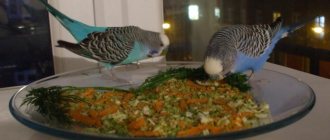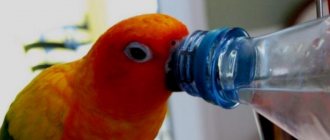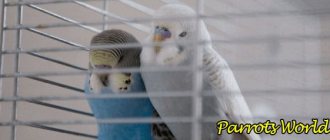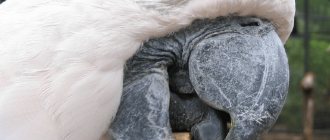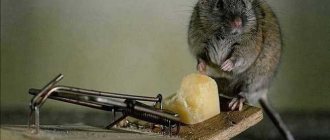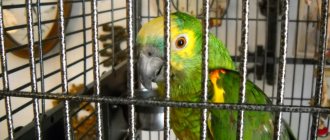Online magazine about parrots
Colors and patterns of budgies
We have translated and compiled for you a guide to the colors and patterns of budgerigars
Look
Popular article
Let's figure out how to choose a mate for a male or female budgie
2
Home › Reproduction
Breeding budgies is considered not too difficult, but a troublesome task. The owner must first perform some steps to allow the birds to prepare for nesting.
To do this, a pair of wavy birds is wisely selected, a large cage is purchased, and a nest or house is made. It is advisable to monitor each stage of bird breeding, as this process is amazing and interesting.
In the article we will discuss the topic of how long budgies hatch eggs and all the subtleties associated with the process.
- How many days does incubation take?
- When do birds start laying their first eggs?
- How birds fly
- What problems arise
- How many days do chicks hatch?
- Useful video
- Conclusion
How many days does incubation take?
Female wavy birds can lay eggs alone, but such eggs do not hatch into chicks. Therefore, if you want to breed, then fertilization is required.
To do this, a pair is carefully selected, and a young female must be chosen for the male, who will not behave aggressively or dominate.
As soon as sympathy appears between two parrots, they will begin to sing, dance and even sleep together. Mating is the culmination of the courtship period. The process is performed for about a week, several times a day. Sometimes fertilization occurs the first time.
The first egg appears approximately 10 days after the birds mate. During this period, the female stops responding to the male, and also tries to spend a lot of time alone, choosing a nest or house for this.
The process of laying eggs is considered exhausting and difficult, so during this period the female behaves tensely and also breathes heavily. It is advisable not to approach the cage at this time so that the bird does not leave the nest. A parrot can lay one egg about once a day. In total, the female lays from 3 to 8 eggs.
If the female has more than 8 eggs, this can lead to difficulties during incubation, since the testicles will not be able to fit under the bird.
The female immediately begins to warm the eggs, a process that takes approximately 22 days to complete. After this, the chicks are born. Hatching time depends on the number of eggs and the age of the parents. The process occurs quickly in summer and in young parrots.
It is also useful to read: Does a budgie need a mate?
Formation of a marriage union
Before you start breeding parrots, you need to remember that these are flocking birds. The breeder brings together several parrots of different sexes in one room, giving them the right to choose the object of affection. A budgie entering childbearing season must go through all stages of courtship, starting from meeting its partner.
Pairing rules:
- Healthy, strong offspring are possible only from parents without blood ties. Inbreeding leads to the appearance of weakened chicks with congenital anomalies. Sick birds with bad heredity do not live long.
- You cannot force a partner on your parrot. Forced marriage can be fruitless. It is better if the newlyweds choose each other themselves, then the offspring of the loving couple will appear soon.
- The suitable age for mating is one and a half years for females and one year for males. Budgerigars reach high fertility indicators at the age of two to four years. They do not lose their ability to reproduce until they are eight to nine years old. Older birds are not suitable for breeding.
- Females usually choose their own “spouse” and subsequently dominate. Experts advise placing a young female with an experienced male who has already established himself as a father. Then, as she grows up, the girl will not show a quarrelsome character, but will learn to obey her partner.
Attention! Birds that are obese, malnourished or during molting are not allowed to mate.
When do birds start laying their first eggs?
If a beginner decides to start breeding wavy fish, then he must be patient with this process, which is divided into several stages:
Initially, you need to choose the right pair so that a trusting and warm relationship is formed between the birds;- the courtship period can even last several months;
- if the female allows the male, then from the moment of mating until the appearance of the first egg, approximately 10 days pass;
- the owner can easily understand when the egg-laying process begins, since the female begins to push away the male, often retreats into the house, and her tail periodically shakes and her breathing becomes heavier;
- before laying itself, the bird plucks its feathers;
- eggs appear daily or every other day, and in young females their number is much greater than in mature birds.
The female does not always begin to warm the eggs immediately, so the incubation process may begin after a few days.
Difficulties of home breeding
Most novice breeders are faced with the fact that their pair does not reproduce, although all conditions for their nesting have been created. And the house hangs, and the food is good, and the daylight hours are correct. But the couple still does not begin to mate, despite all the mutual understanding and positive communication. Why is this happening?
The fact is that parrots are flocking birds, and the process of their reproduction is much easier when they are kept in a flock. For this you need an aviary or a large cage. And the more pairs there are in it, the greater the chance that they will reproduce.
In flocks of more than 20 individuals, the chances of the emergence of pairs in general and clutches of certain pairs are much higher. This is due to the hormonal background that is formed in birds, observing this process. Flocks of smaller sizes reproduce more slowly, and one pair of wavy birds will work on the future young even less willingly.
Sometimes it is quite problematic for novice breeders to breed these ornamental birds for one more reason: they put them in a rather modest-sized cage.
The fact is that females are unlikely to lay eggs in a small space. It just so happens that people sometimes raise two children in a one-room apartment, but parrots do not want to breed in a small cage.
The cage size for a pair of parrots should correspond to the following dimensions:
- length – 60 cm;
- width and height 40 cm.
In addition to the cage, you will need a nesting house. You can make it yourself with your own hands, but you don’t need to hang it right away. The couple must go through all the stages of the relationship and only then, when you see that the birds are mating, you need to install it in the cage.
How birds fly
During this period, each bird has its own responsibilities, so the following features are taken into account:
- the female incubates the eggs almost all the time;
- the male takes care of the girl, so he brings her food and also periodically cleans her feathers;
- sometimes males are constantly near the entrance to the house or nest, talking and singing;
- the female leaves the house to go to the toilet, and at this time a person can clean the nest or add some sawdust, but sometimes the female reacts too aggressively to interference;
- It is forbidden to touch the eggs with bare hands, so you need to wear gloves, otherwise the female may abandon the nesting site;
- periodically the female turns the eggs over for uniform heating;
- after 10 days, you can carefully take the testicle and hold it up to the light to determine whether it is fertilized;
- if a dark spot and a network of vessels are visible, then small chicks can be expected soon;
- if the egg is completely light, then it is represented by a pacifier, but it is advisable to leave it for another 11 days;
- Experienced owners even sometimes clean eggs from bird droppings or seal cracks with adhesive tape, but without experience it is not advisable to perform these actions, as this can lead to damage to the egg.
Did your parrots have chicks?
Not really
The bird incubates the eggs for 20 to 25 days, and
the female maintains an optimal temperature for the embryos, which is approximately 37 degrees .
Sometimes the bird wets the eggs with water from the drinking bowl. She turns them over periodically to ensure even heating, so doing this yourself is not recommended. As soon as the embryos gain enough strength, the process of pecking the shell begins.
In the photo you can see what a fertilized egg looks like:
Best period for breeding
In wild budgerigars living in Australia, the instinct of procreation manifests itself in winter (in the southern hemisphere this is June - August, the rainy season). Domesticated birds are not so tied to a specific time of year; the breeding period is chosen by breeders.
It is better to stimulate the breeding instinct of budgerigars during the summer months. Warmth and long daylight hours promote the production of sex hormones. Our winter and spring are not suitable for pimping, as the birds’ bodies are weakened. The chances of healthy offspring are slim.
Preparation of birds includes a set of actions aimed at improving their health and living conditions:
- increasing the duration of daylight up to 16 hours (adding gradually, 1 - 2 hours a day), turning on additional lighting;
- maintaining the air temperature at least 22 degrees;
- adding mineral elements (calcium, phosphorus) and vitamins to the diet.
An intermediate stage of preparatory activities is hanging the nesting house. Having seen the future “maternity hospital”, the female begins to intensively settle in it - to nest.
Note: a smart breeder plans the nesting of parrots, taking into account his workload. The time of incubation of eggs and feeding of chicks is a busy time when birds require round-the-clock supervision.
What problems arise
The owner must monitor the process of hatching eggs in order to promptly identify any difficulties. With some effort, such problems can be eliminated.
The most common force majeure events include:
- Both parrots are flying . This indicates that the cage contains two females who have reached sexual maturity, but are carrying unfertilized eggs. This is usually associated with a high-calorie diet, so it is necessary to cut back on the diet. Hormonal imbalances may occur, so it is recommended to reduce the amount of fatty foods. If a person is aimed at breeding birds, then he will have to look for a mate for each female.
- The bird pecks the eggs. Often, young females, after laying an egg, immediately begin to peck it. This is usually caused by not having enough calcium, so you need to hang a mineral stone. Other reasons include stress or lack of experience on the part of the wavy. Sometimes birds simply get tired of frequent nesting. Therefore, even during the mating period, it is necessary to establish the nutrition of the wavy animals, and also offer them a sufficient amount of vitamins and mineral stones. If this does not help, then it is advisable to remove the nesting area for a while so that the female can rest. Even the male can peck the eggs, so he needs to be transplanted into a separate cage.
- The chicks die. Sometimes only hatched chicks die, but there is no need to worry right away, since if 1 out of 5 or 6 dies, then this is considered normal. The female cannot warm up all the testicles evenly, so sometimes weak chicks hatch and quickly die. Even birds have genetic problems and developmental defects. Experienced poultry farmers note that there is incompatibility between parrots, so the pair has to be separated. Sometimes chicks die because the female flies out of the nest for a long time during the brooding period, which leads to slow development of the embryos.
To obtain strong and healthy offspring, the female must eat well during the mating and brooding period.
Possible troubles
The most common problems when breeding parrots are:
- female fatigue;
- violation of feeding rules;
- difficulties with egg laying;
- death of offspring.
Sometimes during the laying process, some eggs get stuck in the female's cloaca. Alarming signs include: the bird sitting for a long time on the floor with its legs spread, rapid breathing and lack of appetite.
How to help
Getting stuck can lead to the death of the female. The most reliable action in this situation is to call a veterinarian. Experienced breeders eliminate this problem without a doctor in one of the following ways:
- Place 2–5 drops of oil (vaseline) into the female’s beak.
- Gently take the bird in your arms and massage its back and the base of its wings. This stimulates the contraction of the oviduct.
- Using a syringe without a needle or a soft brush, apply sterilized oil to the opening of the oviduct. Most often they use sunflower or peach.
Important! Lack of heat and lighting also play an important role. For breeding parrots, it is better to choose a time of year with long daylight hours.
Too much incubation
Sometimes it happens that a female incubates her offspring longer than usual. This is an alarming sign for the breeder. This bird behavior may indicate the following problems:
- The male's reproductive functions faded and fertilization did not occur.
- The female is often removed from the clutch. Creates unstable temperature conditions for embryos.
- The humidity level in the room is insufficient.
- Future chicks have a high chance of developing diseases.
- No embryos.
To ensure the viability of future chicks, you should carefully check the condition of the embryos using gloves. This is done when the bird is removed from the nest. When looking at the eggs (opposite the light source), the choroid plexuses and dark core should be visible inside the shell of 15-day-old eggs. If the contents appear clear and the shell is gray or mottled, the baby inside is dead. Such an egg must be removed immediately.
Interesting! Sometimes it happens that a young female lays the first egg at the bottom of the cage. This means her instinct has not yet awakened. The owner should carefully place the egg in the nest and place the female on top. The bird's maternal feelings will appear in the near future.
The female does not hatch eggs
With inexperienced breeders, it happens that the female resists the appearance of chicks even after fertilization. This behavior of the bird is a consequence of a combination of many circumstances, the main of which are:
- incompetence of the parrot owner;
- poor quality care;
- weakness of strength in the expectant mother.
A female who produces offspring too often does not have the opportunity to restore her body. It is recommended to plan mating of birds no more than once every six months. With age, the reproductive capacity of parrots declines. It is better not to select older females for breeding.
It is not uncommon for a bird to not sit on the nest after the first egg. She waits for the others to appear. If a female abandons a clutch that she has sat on for 3-4 days, she is not suitable for breeding. It is urgent to organize artificial heating of the embryos, or to place them in another female.
The female pecks the eggs
This happens for many reasons:
- Inexperience of the bird (first clutch).
- Calcium deficiency in the diet. The female looks for an opportunity to replenish the mineral deficiency by pecking at the shell.
- Stress. When the female is sitting on her eggs, she should not be disturbed.
- The bird is unsuitable for breeding.
Interesting! It is imperative to place a container of water for bathing in the parrots' home so that the female can wet her feathers and moisten the clutch with them.
How many days do chicks hatch?
Usually the first chicks hatch literally 18 days after the start of egg laying. They are born one after another , and a person can periodically look into the nest to catch an amazing moment.
Sometimes the female refuses the chicks, so she does not feed them or kills them altogether. The chicks are blind and also lack feathers.
They cannot feed on their own, and their weight does not exceed 2 grams. They don't roll over or move.
The female feeds the chicks with goiter milk.
The exact time of birth of the chicks depends on the number of eggs, as well as on the time spent by the female on oviposition. Sometimes the last egg lies for up to 28 days, but usually a very weak bird appears.
If there are eggs left after 4 weeks, they should be thrown away. The wavy birds feed their offspring for about 2 months, after which the chicks begin to fly out of the nest. It is at this time that they need to be placed in a separate cage, and also distributed to new owners.
The female needs to rest before the next mating, so it is necessary to remove the nesting area, and it is also advisable to separate the pair for a while.
Building a nest house with your own hands
If you decide to make your own nest, there are a few things you need to know.
Firstly, all boards prepared for work must be disinfected and disinfected.
Secondly, the standard dimensions of the nest are 20*20*25 centimeters. However, this does not mean that you should create a house of exactly this size. It’s just that the indicated dimensions should be taken as a basis when building something similar.
Thirdly, you will need to hollow out a small depression at the bottom of the house. It is in it that the eggs laid by the female will subsequently be located. This is done so that the laid eggs do not roll out throughout the entire nest house.
Also, you will need to cut a hole in one of the side walls through which the birds can get inside the house you have built. You will need to attach sticks under the cut hole and on its inside. This way, it will be much more convenient for the birds to get in and out of the nest house. Once everything is ready, place some sawdust inside the nest.
popyga.ru
Disinfection
Be sure to disinfect all items you will need during this time. The cage, drinkers, feeders and toys are soaked in hot water with a weak bleach solution, and then rinsed thoroughly. The house itself is disassembled, cleaned with baby soap, dried, then calcined in the oven at 120 degrees for 30-40 minutes, some, after a good bath of the nest, calcine it on a gas burner until the outer wall becomes hot - it all depends on how and what it is made of.
It would be a good idea to add dry medicinal chamomile to the sawdust that you will add to the nest - it prevents the appearance of gamas mites.
The appearance of the first eggs
If a parrot of different sexes is kept together, at some point they will develop a mutual liking. A man matures earlier - at the age of 6 months he is ready to reproduce. How long does it take for a woman to prepare her body for reproduction? 8-9 months is the right age for coverage.
During training, the parrot is inseparable: a lot of communication, wearing feathers, sleeping next to each other. The parrot cheerfully displays its talents, dances, and also feeds your partner with its beak. Then there is the lifting point of the relationship - opacity. This happens several times a day for a week.
After fertilization, the egg forms in the woman's stomach within 24-48 hours. Instinctively, the bird grabs the feathers under its tail and belly and covers them with its nest. He spends less time with his partner, trying to be alone.
Signs that a woman is ready to introduce eggs:
Fertilization is a complex process that consumes the delicate female frilled parrot. There are situations where a young bird does not breed properly. If help is not given on time, it may lead to the death of the parrot.
If the birth is successful, a small white egg will appear in the slot. The bird is not sitting on it right now. Most often, incubation of chicks begins with the appearance of the second or third egg. 4-6 eggs are considered normal.
Note. Solo planes sometimes lay eggs and even attempt to incubate them. This phenomenon is not uncommon without poultry, it is the body's reaction to excess protein in food. So what to do? It is necessary to remove blocked eggs from the cage, and also take care of mineral feeding.
The appearance of chicks
Towards the end of the incubation period, a chip appears on the shell - this is the chick starting to make its way to the exit. In the upper part of the beak there is a thickening - an egg tooth, with which the bird cracks the shell. If the baby is not strong enough, the mother herself cracks the shell, helping the chick escape. Delivery "requires high humidity, otherwise the inner foil may stick to the skin of the chicken.
Grooved parrot chicks
The difference between the first and last baby can be a little more than a week. It is not difficult to calculate how many days whole eggs can live in a nest: chicks should not wait more than four weeks. The empty clutch must be removed to allow the female to complete the hatching process and fully care for her brood.
When a pet parakeet is incubating eggs, there is no need to interfere with the process, no matter how interesting it may be. Human assistance to animals can take the form of feeding, creating a favorable microclimate and a peaceful environment. Natural instincts will tell the bird how to reproduce and raise its offspring.
Reasons why the clutch turned out without fertilized eggs or with frozen
When there are one or two frozen eggs in the clutch, there is no need to worry. Even due to inexperience, the female may not have warmed all the eggs evenly. If all the offspring died, it is worth thinking about the reasons.
These could be infectious diseases of parrots, improperly formulated bird nutrition, poor-quality water, genetic incompatibility of parents, inappropriate humidity in the apartment, or the female is not able to hatch eggs normally.
As for unfertilized eggs, the most common reason is that the birds were not properly prepared by the breeder. But it happens that the reason lies in health problems in one or both parrots. Even the wrong location and quality of the perches can affect the result.
Moment of birth
Before the egg appears, the bird becomes calm and focused. The abdomen sinks and swells, breathing becomes difficult. The pet sits in the nest and does not want to communicate. Sometimes childbirth is accompanied by cramps and bleeding.
To alleviate the condition, the female is fed baby food diluted with drinking water. Heating is increased slightly by bringing the light source under the bottom of the cage no more than half a meter, maintaining a temperature of 37°.
To avoid diarrhea, the pet is limited in its consumption of soft green food. Labor ends when the egg slips out of the bird's body. Subsequent ones come out every other day. As soon as 2-3 eggs appear, the female sits down to incubate the offspring.
Male courtship
During the mating season, the male's cere becomes a rich blue color, while the female's is brown, even slightly enlarged. This is a sign of raging hormones. The male's courtship becomes more intrusive; some females hardly eat until the male feeds them, although they themselves are not yet sitting in the nest.
Photo: Matt Francey
It is very interesting to watch the wavy couple cooing before mating. The male begins to actively nod his head, chirp, and dancing and chatting begin - the parrot knocks with its beak on all objects and on the beak of the female. Sometimes the female takes part in the dance. Making all kinds of sounds, the male does not forget to treat the young lady with food from his beak. This ritual seems to confirm the seriousness of the male’s intentions. After all, after the female goes to the nest to incubate the eggs, the male becomes the main breadwinner and guard.
What to feed
Parrots that have entered the breeding phase show increased interest in mineral nutrition. Make sure that there is always sepia, mineral mixture, stone in the cage. Chalk is suitable as a source of calcium. You can simply crush calcium gluconate tablets and add them to the grain mixture, which has been slightly moistened beforehand. Mineral substances entering the body of the expectant mother are absorbed and help avoid the fragility of the shell.
The health of mating parrots directly depends on proper maintenance and good food. Future parents deserve enhanced nutrition:
- The awakening of the sexual instinct is facilitated by the consumption of sprouted grains;
- For the normal formation of eggs, unleavened cereals, kefir, and vegetables are added to the usual menu of budgies;
- This is a popular treat for nesting birds among breeders: a salad of grated carrots, chopped eggs, cottage cheese and sprouts. This dish is not for every day, but eating this mixture twice a week is very useful.
As soon as the female lays eggs and begins to incubate them, stop giving her soft food and increase the daily intake of grains and seeds. The female spends a lot of energy heating the eggs; she needs high-calorie food. The water in the drinking bowl must be changed frequently for fresh water. A bird can get sick by drinking stagnant liquid.
Attention: picky birds that feed only on grain should not be allowed to nest. A monotonous diet worsens the health of parrots and does not contribute to the emergence of strong chicks.
